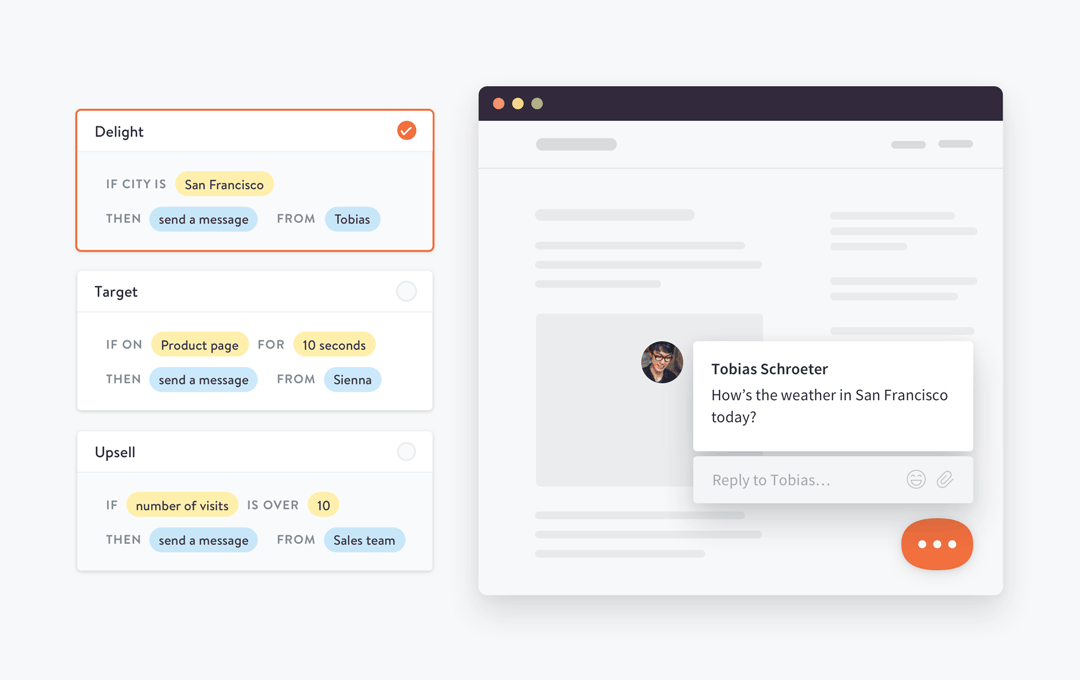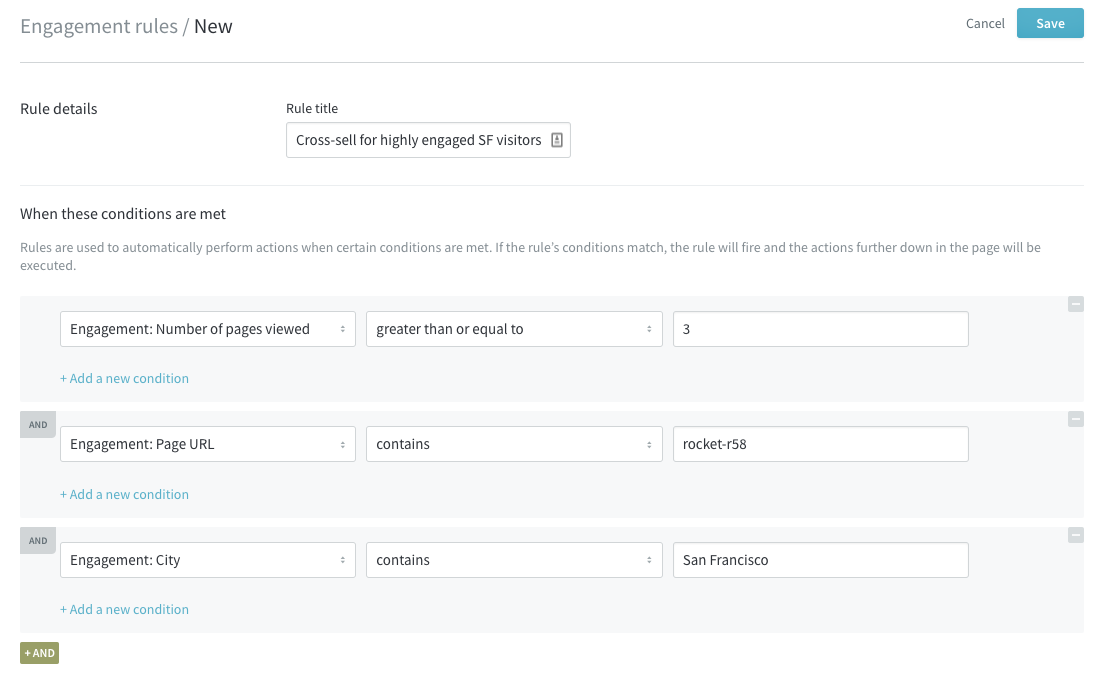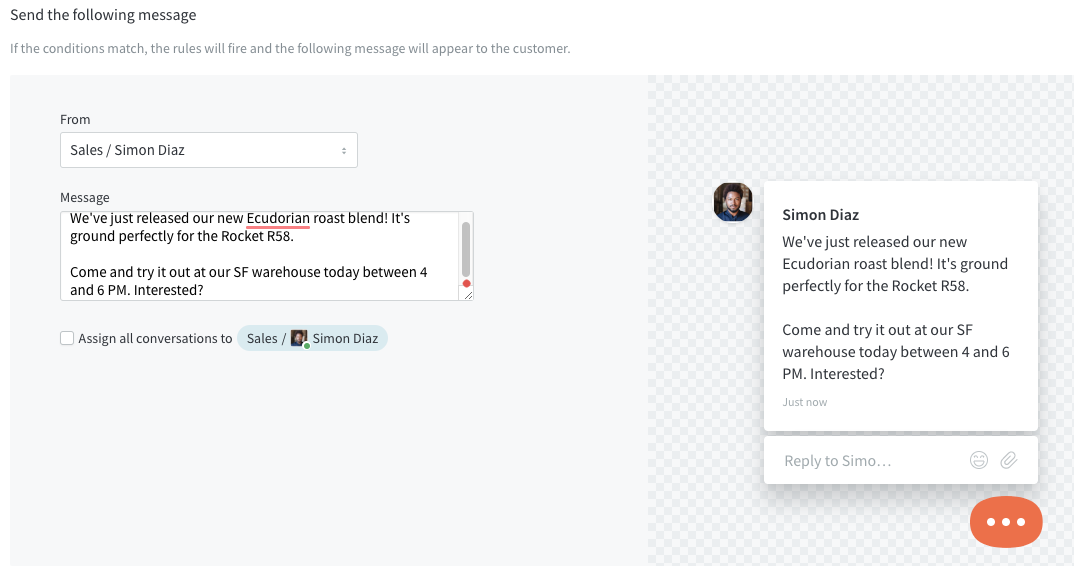Live chat’s opportunity to grow a business is taken for granted. Many businesses are missing out on driving leads, sales, and revenue.
Live chat is often seen as an online support tool for existing customers. It’s a popular alternative to email support because instant discussions resolve simple queries. This explains why it’s the most favored support channel, as over 41% of consumers prefer to use live chat instead of email, phone and social media support.
Used correctly, live chat has the ability to grow your business. Live chat can keep customers returning and attract prospective customers.
How live chat customer engagement can grow your business
We conducted a survey of 1000 consumers, asking about their live chat experiences. Three key insights stood out that change the way businesses should think about live chat.
The results tell us that live chat can:
- Increase sales
- Boost loyalty
- Grow brand awareness
1. Live chat drives sales
38% of consumers are more likely to buy from a company if they offer live chat support
Even before a customer has purchased from you, the support channels you offer can have a big impact on the likelihood of conversion.
Our report shows that almost 4 in 10 consumers are more likely to buy from a company if they offer live chat as a support option, even if they don’t use it. This suggests that the availability of live chat is not just a contact method, but indicative of the approach a company takes.
Businesses that offer live chat are seen as more approachable, helpful, and customer-centric. So consumers feel more comfortable doing business with them.
2. Live chat drives loyalty
51% of consumers are more likely to stay with or buy again from a company if they offer live chat support
Consumers are more likely to stay with or repurchase from a company when they offer live chat support.
Live chat offers reassurance to buyers as it’s a click and message away. This comfort makes them want to come back to your business.
When a customer does need help post-purchase, if your support can live up to the customer’s expectations this will increase loyalty.
3. Live chat grows awareness
29% of consumers have told friends or colleagues about a positive live chat experience
Word of mouth is one of the most authentic marketing tactics available, but it’s uncontrollable and cannot be influenced. This means it’s more important than ever to impress and delight customers through their experiences with your business.
Our statistics show that one in three consumers have spread positive word of mouth after a successful live chat experience.
This gives brands an opportunity to create advocates, build awareness, and create a loyal following through delightful live chat experiences.
But you must deliver support that meets the customers expectations, as 20% of consumers have spread negative word of mouth after poor live chat experiences. Customers demand an effortless experience on live chat.
Live chat: the missed revenue opportunity
Online retailers and services have the biggest opportunity and might be missing out. We discovered that:
- Consumers who spend between $250 and $500 a month online, are the most likely to be influenced by the availability of website with live chat.
- 45% of those big-spend consumers are more likely to buy from companies who offer live chat support, and two-thirds are more likely to be loyal too!
This suggests that offering live chat support is more likely to increase revenue and attract consumers with higher disposable incomes.
Businesses should use live chat customer engagement features to drive even more revenue from those customers with proactively targeted relevant messages.
Maximize sales and engagement with proactive engagement

With modern real-time messaging apps, you don’t need to wait for a customer to contact you. Customer engagement features let you proactively reach out to users on your website. This opens up a world of possibilities to target, engage, and convert visitors into customers.
Use live chat customer engagement to reduce customer effort
Customers want to be engaged proactively, it’s how they want to receive service updates—and it keeps them loyal!
- According to a study by InContact, 87% of customers want to be proactively contacted regarding customer service issues.
- Enkata found that proactive customer service can reduce contact center calls by 20-30% over twelve months and also positively improve customer retention by up to 5%.
- The Effortless Experience, by CEB Insights, found that the less effort for customers to get support also correlated with an improvement in loyalty.
Use live chat customer engagement to increase purchases
For eCommerce companies, where on average 98% of visitors arrive on websites without buying anything, there’s also money to make by proactively engaging customers. US retailer Sam’s Furniture generated an additional $50,000 per month by encouraging customers to start a live chat on their website.
What’s your proactive engagement strategy?
To make sure you’re approaching proactive engagement effectively, you’ll want to take a more holistic approach.
1: Set your goals
How you want live chat to work for your business depends on your industry, business model, and customers. Proactive engagement can meet many goals. Let’s look at three different types of business and what goals they want to hit with proactive engagement:
- A SaaS company might want to engage warm leads.
- An eCommerce retailer might want to upsell visitors who have been on the site before.
- An architectural firm might want to engage everyone to capture potential interest.
Having a clear goal in mind will help you set tight targeting criteria, align messages with the outcome you have in mind, and help you choose metrics to use for further optimization.
In this quick walkthrough, we’ll look at how Brewfictus—a fictional coffee equipment supplier—creates an engagement rule in Kayako. Their goal is to cross-sell their new bean roasting product to local visitors in San Francisco.
2: Consider your audience
Based on your goal, you can then determine the correct audience to engage. This may be broad and generic (like ‘all visitors’) or more specific (like ‘visitors on the pricing page, who have viewed at least two other pages’).
With proactive engagement in Kayako, you can set audience criteria like:
- the number of pages a visitor has viewed
- the number of visits they’ve made to your website
- whether page title or URL contains a phrase or keyword
- a specific referrer URL
- city, country, or language
These targeting options give you control over the specific people you want to engage.
Here’s an example of how Brewfictus set up their engagement rule to target highly engaged visitors (who’ve viewed over 3 pages), in the city of San Francisco, and who are looking at a relevant product web page.

3: Consider timing
It’s not enough to send the right message to the right people. You need to ensure visitors receive the message at the right time.
Time-based targeting options come in handy here.
Time-based targeting enables you to delay messages until the visitor is more engaged with your page or website. This increases the likelihood that the visitor will interact with the proactive message.
Kayako Messenger can start conversations at anytime—even when your team aren’t online. But we recommend you send these messages only during business operating hours to prevent a poor user experience.
In our Brewfictus example, they’ve already qualified that a visitor is highly engaged, so setting the engagement to appear after three seconds is a good place to start. They’ve also selected it to show only during business hours, so customer replies can be answered immediately.

4: Craft your message
Now, it’s time to focus on the message that visitors to your website will see. Revisiting your goal will help you with the best direction for your goal and audience.
You’ll need to consider the space available, and how to best grab your visitor’s attention in as few words as possible. For example, proactive messages in Kayako Messenger can be up to 244 characters before they’re clipped, so it’s important to be brief.
When crafting your live chat engagement message, try to:
- Be personal and specific: remember, live chat is a one-to-one communication tool, not one-to-many
- Contain a call-to-action or ask a question: depending on your goal, you’ll want to get a customer to take action on the page or start a live chat conversation
- Highlight urgency: nothing encourages action more than the thought of missing out on something.
Here’s the message that Brewfictus send using the criteria they defined above.

5: Measure results and optimize
After setting your engagement rule live, it’s worth revisiting every week to ensure it’s still performing for you. You’ll want to measure on two counts: performance, and quality.
Kayako gives you real-time performance stats, so you can see how many people your message was delivered to, how many people have engaged with it, and ultimately how many conversations were created. From here, you can edit and amend your message criteria, timing, and text to optimize based on the metric you’re looking to improve.
After a few days, our fictional Brewfictus coffee suppliers look at their results, and see that the message was delivered to 70 visitors, clicked on by 16, but only two conversations were started.

Armed with this information, Brewfictus can revisit their targeting and message to improve engagement, and get more people into their store!
Quality of conversations is much more subjective. At Kayako, we track quality using a custom field with a simple yes/no option to answer whether the conversation was worthwhile. We run reports that then help us correlate quality conversations and their source, so we can further improve targeting.
Don’t miss out on the proactive live chat opportunity
Businesses all around the world in every industry are learning how live chat proactive engagement can drive more leads, win new customers, and help grow revenue by smartly engaging visitors with relevant, personal messages at the right time.
What results could you see with proactive live chat engagement on your website? Let us know in the comments.
[hs_action id=”9889″]